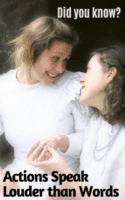Lucy stared from across the room. Her eyes met his. Despite not saying a word to each other their body language said everything. Her pupils dilated, she dropped her folded arms to her sides indicating that she was interested. In the corner of the room was Jane. She was being chatted up by some guy she clearly wasn’t interested in. Besides the vague answers she gave, her arms were folded while quickly tapping her fingers as she gave no eye contact. The contact between these people has almost no verbal communication however, their body language is speaking louder than words. This nonverbal communication is said to make up to 93% of our communication while only 7% is said to be spoken words.
Body language and nonverbal communication
According to an article by Study body language, “Nonverbal communication is communication without using words – simple. Body language is a branch of this communication focusing mainly on the different body gestures and facial expressions.”
According to Psychology Today, the belief is that 55% of communication is body language, 38% is the tone of voice, and 7% is the actual words spoken.
This percentage breakdown was expressed by Dr Albert Mehrabian when he conducted an experiment in 1967 on 30 participants, all female. It goes without saying that this data is rather limited and therefore it should be clear that despite the 55/38/7 rule, it only applied to this specific experiment. However, it also doesn’t mean that the 55/38/7 rule is completely wrong.
Nonverbal communication and the 3 Cs
One way to be sure of what nonverbal communication may be in a certain situation is to add the 3 Cs, namely context, clusters and congruence.
Context refers what environment the situation is taking place in, the history between the people, etc., like a boss and an employee. Clusters refers to the grouping of gestures to determine what the person means. This shouldn’t be analysed to intently as let’s say you’re sitting with someone on a date outside and their arms are folded, it doesn’t necessarily mean they’re not interested, maybe they’re just cold. Congruence refers to whether the spoken words match body language. So if your friend just goes through a breakup and you ask if she’s alright and she says yes but her eyes say something different then maybe it would be better to ask a follow-up question like, ‘Are you sure?’
Psychologist, Jeff Thompson reminds us that, “The 55/38/7 percentage and the 3 Cs of Nonverbal Communication remind us that, when trying to understand others, a single gesture or comment does not necessarily mean something. Instead, these theories allow us to take note and observe more to get a better understanding of what is going on.”
Forms of body language
Since body language has such a high percentage of nonverbal communication it’s important to understand the depth of it.
• Facial expressions – Facial expressions are a universal form of body language. Showing happiness, anger or fear is the same worldwide.
• Eye signals – Eye signals include eye gaze, blinking and pupil size.
• The mouth – A smile may be genuine, or it may be used to express false happiness, sarcasm, or even cynicism.
• Gestures – Some gestures may be cultural, for example, giving a thumbs-up or a peace sign in another country might have a completely different meaning than it does in South Africa.
• Arms and legs – Crossing the arms can indicates defensiveness and even discomfort. Crossing legs away from another person may show dislike or discomfort with that person.
• Posture – Posture can indicate how a person may be feeling and reveal something about our personality, like whether someone is shy or confident.
• Personal space – This is also referred to as proxemics which is the distance between people as they interact. There will be different physical distances between you and your partner compared to you and a stranger. There are also different types of distances.
An article by Very Well Mind states that, “Research even suggests that we make judgments about people’s intelligence based upon their faces and expressions.”
It’s important to realise that we need all forms of communication to convey a certain message because even though 7% of communication is words spoken and 93% is tone and body language, there are naturally things that you simply have to convey by speaking.
Nonverbal communication will always play a crucial role in the way we convey certain things and how the information is presented to others but also how we interpret the actions of others.
It’s important to remember when looking and interpreting nonverbal cues, you have to think about the cues in groups and not one single gesture. Look at expressions, appearance and tone of voice to understand what someone might be saying despite not actually saying it. So the next time when talking to someone remember to pay attention to the nonverbal cues. As the famous saying goes, “Actions speaks louder than words”.
***
Learn more about the power of the mind here.
Tell us: Can you remember a time when you said something but your body language said something different?


